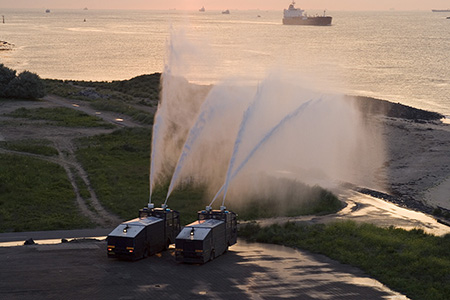Göteborg International Biennial for Contemporary Art

‘Play!’, the title of this year’s Göteborg International Biennial for Contemporary Art, has a cumbersome subtitle: ‘Recapturing the Radical Imagination’. Under the artistic directorship of Edi Muka, the biennial is divided into four sections with nearly 50 artists and collectives, each with a different curator. The core section – and the one that best encapsulates the show’s title – was Katerina Gregos’s ‘The Politics of Play’ at Röda Sten Konsthall. Gregos proposes that, in addition to (or in the absence of) viable political positions or activist strategies in contemporary art, artists can take up various forms of play – satire, comedy, games, performance – to question dominant political, social or institutional systems. Satirical political TV programmes like The Daily Show succeed at this, and have even become vehicles for political opinion-making. But the kind of attempts here, on the whole, have less success. Efforts like the mock-Band Aid music video We need you now (more than ever) (2012) by Copenhagen-based collective Wooloo (in which artists and curators make cameo appearances asking for charity from the Catholic Church) fall flat, largely because they are neither funny nor subversive.
In parts of the Konsthall, Gregos’s proposal did seem to gel. Ninar Esber’s Triangle (2012), in particular, shows how biting wit can expose the absurdity of a religious or political system. Set to a punk anthem, Esber’s video scrolls quotes from Sharia law and various fatwas aimed at women: ‘Women who show their hair’; ‘Women who ask for a divorce’; ‘Women who display their charms’. The chilling part of reading this series of truncated rules derives from the fact that the artist omits the punishments, so we don’t know the outcome of their violation. As the list goes on, it transforms into a sort of potential manifesto, turning the negative directives into positive feminist resistance groups. Displayed directly beside Tala Madani’s animations and paintings of men made out to be foolish or ineffectual, the feminist theme is bolstered. On the other hand, the Guerilla Girls’ protest banners, hung on a pink wall, seem dated and idealistic. Their sloganeering (for example, ‘The Homeland Terrorist Alert System for Women’) highlights the overall sense of disillusionment that pervades the contemporary work here. I came away from this part of the show feeling that today’s art often reflects our current sense of cynicism about not only political art that manifests real political change but also activism that acts. Instead of action, we’re left mocking our own inaction in a kind of hopeless, self-reflexive irony and fear.
In a developing strip of land outside Röda Sten, the section ‘Art and Crime: Legally on the Edge’, curated by Joanna Warsza, effectively makes use of various public and private spaces alongside the harbour. In an Ibis hotel located in a docked boat, Jill Magid’s video The Capitol Shooter: Breaking News (2011–12) – in which the artist inserts herself as a witness into a newscast about a shooting in Texas – is installed on a television screen above the reception desk, while her 2012 novel Failed States, inspired by a trip to Afghanistan, is placed on nightstands in each of the hotel’s room. At Göteborgs Konsthall, the section curated by Claire Tancons, titled ‘AnarKrew: An Anti-Archives’, was inspired by archival imagery from 1982–93 of Gothenburg’s annual Carnival, and how the event came to function as a countercultural movement that represented the city’s underprivileged classes. Here, Sonia Boyce’s stunning new film MOVE (2013) features female dancers performing graceful, deliberate movements in the streets of Gothenburg. The dancers are re-enacting and re-interpreting events from the city’s Carnival, as well as from the protests that took place in 2001 during the EU–US summit in Gothenburg, in a work that elegantly draws parallels between protest and play.
The opening weekend featured the performance programme ‘Weight’, curated by Icelandic artist Ragnar Kjartansson and Swedish artist and writer Andjeas Ejiksson. This part of the show, which took place in the Stora Theatre, featured a truly carnivalesque and dizzying centrepiece performance by Spartacus Chetwynd (who has since changed her first name to ‘Marvin Gaye’) entitled Atlas Kissed (2013), featuring spinning Op-art props moved back and forth across the stage by actors. Installed in the theatre’s mirrored and chandeliered ‘Crystal Foyer’ was the video and slide projection Infinity Kisses (2008) by Carolee Schneemann (who, decades before Matthew Barney, suspended her body from a roped harness to create a large-scale drawing); Schneemann was cited as the curators’ main source of inspiration. The work features a seemingly endless series of self-portraits of the aging artist kissing her cat on the mouth, merging two of the Internet age’s most common themes (selfies and cats), but also exposing herself, quite bluntly, as a ‘crazy old cat lady’. In a biennial where the majority of stand-out works were made by female artists (and curators), to have the grande dame of performance art placed centre-stage with this kind of moving and yet playful work felt right. No doubt in reference to Schneemann’s work, in a rehearsal room upstairs, William Hunt’s human Calder-esque mobile was as awkward for the audience to watch as it must have been for dancers to perform (Paranalia – For 5 dancers; an exercise in suspension, cooperation and obstruction, 2013). Suspended in harnesses, bobbing and rotating, the dancers’ movements suggested that ‘play’, when mixed with art, takes on the literal weight and heft of human bodies, but also the deliberate and awkward weight of exposition. Seeing the performers struggling to hand each other sandbags to even out the balance of the slowly spinning mobile felt like an apt metaphor for attempting to find the difficult balance between art and play.















